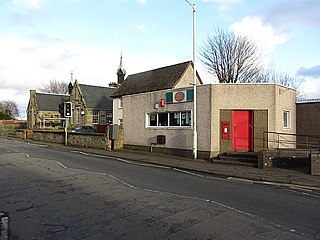
Kinglassie is a small village and parish in central Fife, Scotland. It is located two miles southwest of Glenrothes. It has a population of around 1,900 (2022) The civil parish has a population of 22,543.

Newport-on-Tay is a town in the north-east of Fife in Scotland. The Fife Coastal Path passes through Newport-on-Tay. The area itself has views of the two bridges that cross the River Tay and distant views of the Scottish Highlands.

Dunfermline is a city, parish, former Royal burgh in Fife, Scotland, 3 miles (5 km) from the northern shore of the Firth of Forth. Dunfermline was the de facto capital of the Kingdom of Scotland between the 11th and 15th centuries.
Cupar is a town, former royal burgh and parish in Fife, Scotland. It lies between Dundee and Glenrothes. According to a 2011 population estimate, Cupar had a population around 9,000, making it the ninth-largest settlement in Fife, and the civil parish a population of 11,183. It is the historic county town of Fife, although the council now sits at Glenrothes.
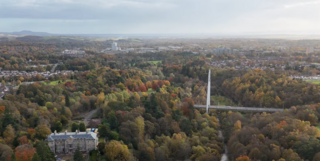
Glenrothes is a town situated in the heart of Fife, in east-central Scotland. It had a population of 39,277 in the 2011 census, making it the third largest settlement in Fife and the 18th most populous locality in Scotland. Glenrothes is the administrative capital of Fife, containing the headquarters of both Fife Council and Police Scotland Fife Division and is a major service centre within the area.

Pittenweem ( ) is a fishing village and civil parish in Fife, on the east coast of Scotland. At the 2001 census, it had a population of 1,747.

Thomas Hamilton was a Scottish architect, based in Edinburgh where he designed many of that city's prominent buildings. Born in Glasgow, his works include: the Burns Monument in Alloway; the Royal High School on the south side of Calton Hill ; the Royal College of Physicians of Edinburgh; the George IV Bridge, which spans the Cowgate; the Dean Orphan Hospital, now the Dean Gallery; the New North Road Free Church, now the Bedlam Theatre; Cumstoun, a private house in Dumfries and Galloway; and the Scottish Political Martyrs' Monument in Old Calton Cemetery, Edinburgh.
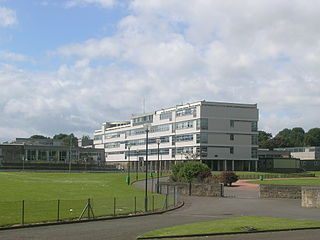
Balwearie High School is a non-denominational comprehensive secondary school at the west end of Kirkcaldy in Scotland. Balwearie serves around 1600 pupils aged from 11 to 18 and includes a Department of Additional Support for children with Additional Support Needs.
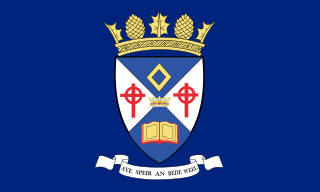
Currie is a village and suburb on the outskirts of Edinburgh, Scotland, situated 7 miles south west of the city centre. Formerly within the County of Midlothian, it now falls within the jurisdiction of the City of Edinburgh Council. It is situated between Juniper Green to the northeast and Balerno to the southwest. It gives its name to a civil parish.

Elie and Earlsferry is a coastal town and former royal burgh in Fife, and parish, Scotland, situated within the East Neuk beside Chapel Ness on the north coast of the Firth of Forth, eight miles east of Leven. The burgh comprised the linked villages of Elie to the east and to the west Earlsferry, which were formally merged in 1930 by the Local Government (Scotland) Act 1929. To the north is the village of Kilconquhar and Kilconquhar Loch.

Inverkeithing High School is a secondary school located in Inverkeithing, a historic town on Fife's southern coast 3½ miles from Dunfermline city centre, 9½ miles from Edinburgh city centre, and in between the towns of Dalgety Bay, Rosyth and North Queensferry.
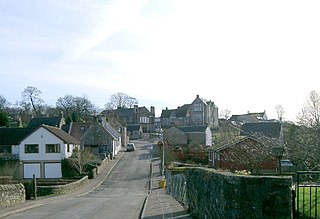
Saline is a village and parish in Fife, Scotland, situated 5 miles (8.0 km) to the north-west of Dunfermline. It lies in an elevated position on the western slopes of the Cleish Hills.

Kingskettle or often simply Kettle is a village and parish in Fife, Scotland. Encompassed by the Howe of Fife, the village is approximately 5.5 miles (9 km) southwest of the nearest town, Cupar, and 22 miles (35 km) north of Edinburgh. According to the 2011 Census for Scotland, the Kettle parish had a population of 1,645, of which 1,002 lived in the village.

The Golf House Club, Elie established in 1875, is a historic members golf club located in the East Neuk of Fife, Scotland. Members have playing rights over Elie Links, a UK Top 100 Golf Course.

John Tait (1787-1856) was a Scottish architect operating in the first half of the 19th century responsible for several fine streets in Edinburgh all of which are listed buildings. One of his creations, 15 Rutland Square, houses the Royal Incorporation of Architects in Scotland.

Crail Tolbooth and Town Hall is a municipal structure in Crail, Fife, Scotland. The building, which stands in Marketgate, at its junction with Tolbooth Wynd, is Category A listed.

John Currie was a Scottish architect, prominent in the 19th and early 20th centuries. He designed several notable buildings in Scotland, including town halls, schools and churches. Several of his works are now listed buildings.
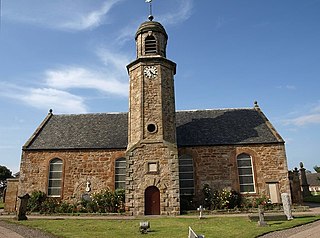
Elie Parish Church is a church building in Elie, Fife, Scotland. It is Category B listed, its oldest surviving part dating to the 1726.

Crail market cross is located in Crail, Fife, Scotland. Erected in the early 17th century and now Category B listed, it is a mercat cross with a square chamfered shaft set on a stepped base. It has a capital and unicorn finial, added in 1887 by Fife architect John Currie.
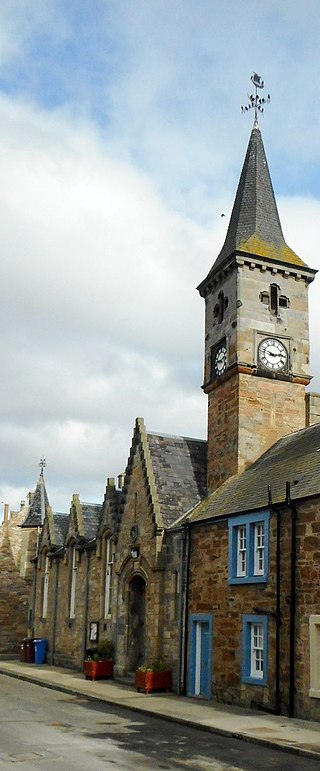
Elie and Earlsferry Town Hall is a former municipal structure in High Street in Elie and Earlsferry, Scotland. The structure, which is currently used as an events venue, is Category B listed.



















